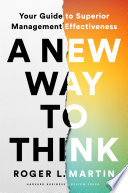

The book emphasizes the importance of mental models in shaping our understanding of the world. Mental models are frameworks that help us interpret information, make decisions, and solve problems. The author argues that by developing a diverse set of mental models, we can enhance our critical thinking skills and approach challenges more effectively. This idea encourages readers to broaden their perspectives and consider various viewpoints when analyzing situations. The author provides examples from various fields, including science, economics, and psychology, illustrating how different mental models can lead to innovative solutions. By cultivating a rich toolkit of mental models, individuals can navigate complex problems with greater agility and creativity.
Continue readingA central theme of the book is the necessity of embracing uncertainty in decision-making. The author posits that in a rapidly changing world, certainty is often an illusion. Instead of striving for absolute certainty, individuals should learn to make informed decisions in the face of ambiguity. This involves recognizing the limits of our knowledge and being open to revising our beliefs based on new evidence. The book provides strategies for managing uncertainty, such as scenario planning and probabilistic thinking. By accepting uncertainty, individuals can reduce anxiety and enhance their ability to adapt to changing circumstances, ultimately leading to more resilient decision-making.
Continue readingThe author advocates for a systems thinking approach to problem-solving, which involves understanding the interconnectedness of various components within a system. This perspective allows individuals to see the bigger picture and recognize how changes in one area can affect others. The book discusses the importance of feedback loops, leverage points, and systemic structures in shaping outcomes. By applying systems thinking, individuals can identify root causes of problems rather than merely addressing symptoms. This approach fosters holistic solutions and encourages collaboration among diverse stakeholders, as it acknowledges the complexity of real-world issues.
Continue readingCreativity and innovation are highlighted as essential components of effective thinking. The author argues that fostering a culture of creativity is crucial for personal and organizational success. The book explores techniques for enhancing creativity, such as brainstorming, lateral thinking, and design thinking. It emphasizes the importance of creating an environment that encourages experimentation and risk-taking. By prioritizing creativity, individuals and organizations can develop groundbreaking ideas and solutions that drive progress. The author provides case studies of companies that have successfully embedded creativity into their cultures, illustrating how it can lead to sustained competitive advantage.
Continue readingThe book underscores the significance of collaboration in harnessing collective intelligence. The author argues that diverse teams bring together a wealth of perspectives and experiences, leading to more innovative solutions. The book discusses strategies for fostering collaboration, such as creating inclusive environments, leveraging technology for communication, and encouraging open dialogue. By valuing diverse input and promoting teamwork, organizations can tap into the collective intelligence of their members, resulting in enhanced problem-solving capabilities. The author also explores the role of leadership in facilitating collaboration and creating a culture that values contributions from all team members.
Continue readingThe author highlights the importance of viewing failure as a learning opportunity rather than a setback. The book discusses how a growth mindset can transform our approach to challenges and setbacks. By analyzing failures and extracting valuable lessons, individuals can develop resilience and improve their future performance. The author provides examples of successful individuals and organizations that have embraced failure as a stepping stone to success. This idea encourages readers to shift their perspective on failure, fostering a culture that values experimentation and continuous improvement.
Continue readingA recurring theme in the book is the necessity of lifelong learning in a rapidly evolving world. The author argues that staying relevant requires a commitment to continuous education and skill development. The book provides strategies for cultivating a learning mindset, such as seeking feedback, pursuing new experiences, and engaging in reflective practice. By prioritizing lifelong learning, individuals can adapt to changing circumstances and seize new opportunities. The author emphasizes that in an era marked by technological advancements and shifting job landscapes, those who embrace learning will thrive.
Continue reading